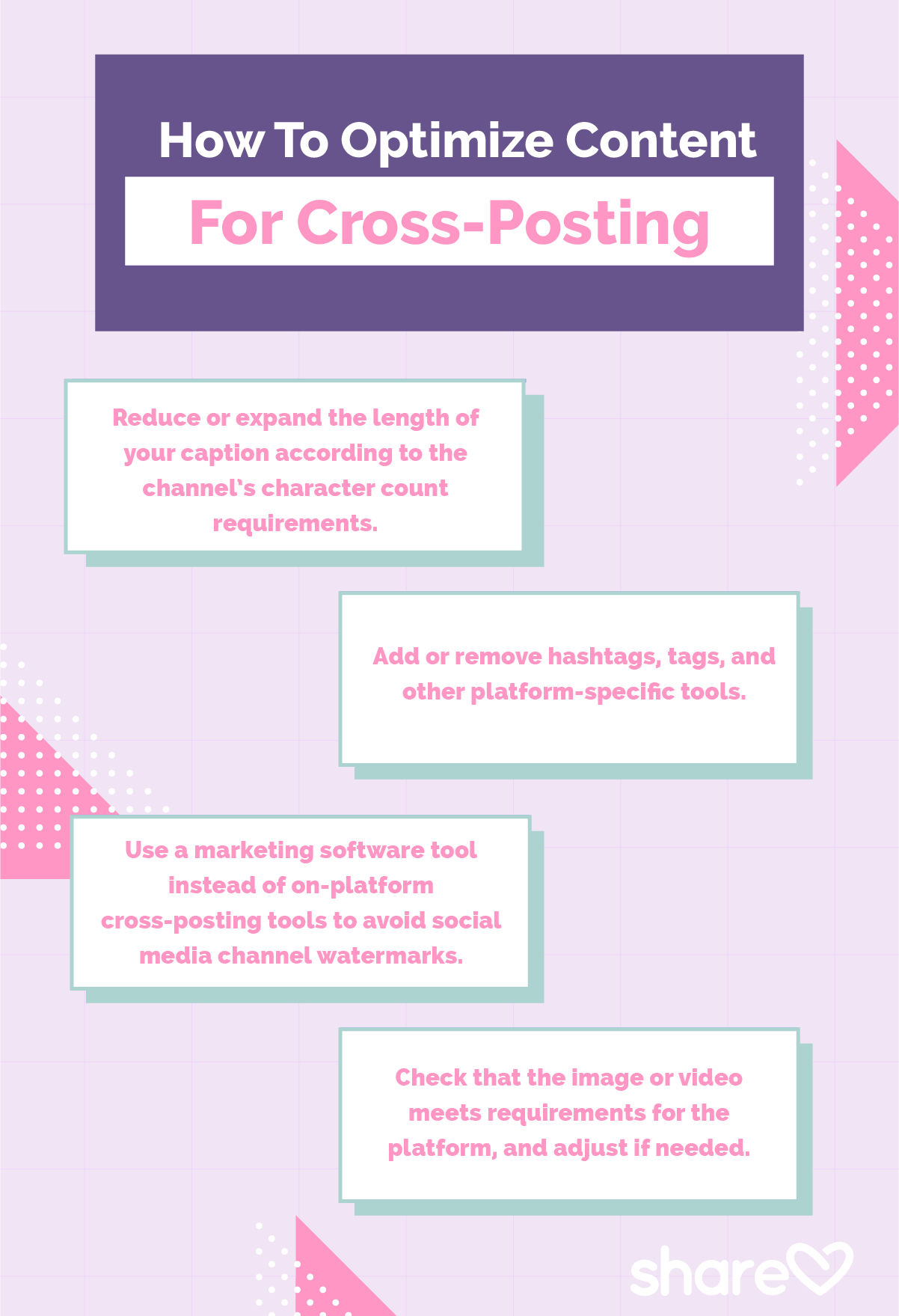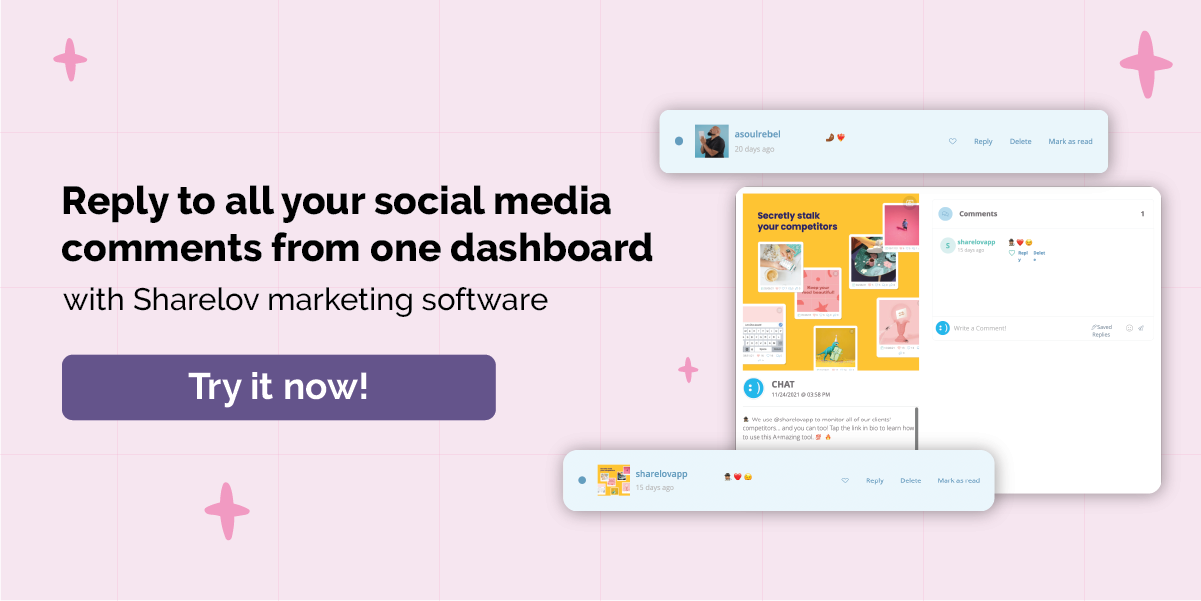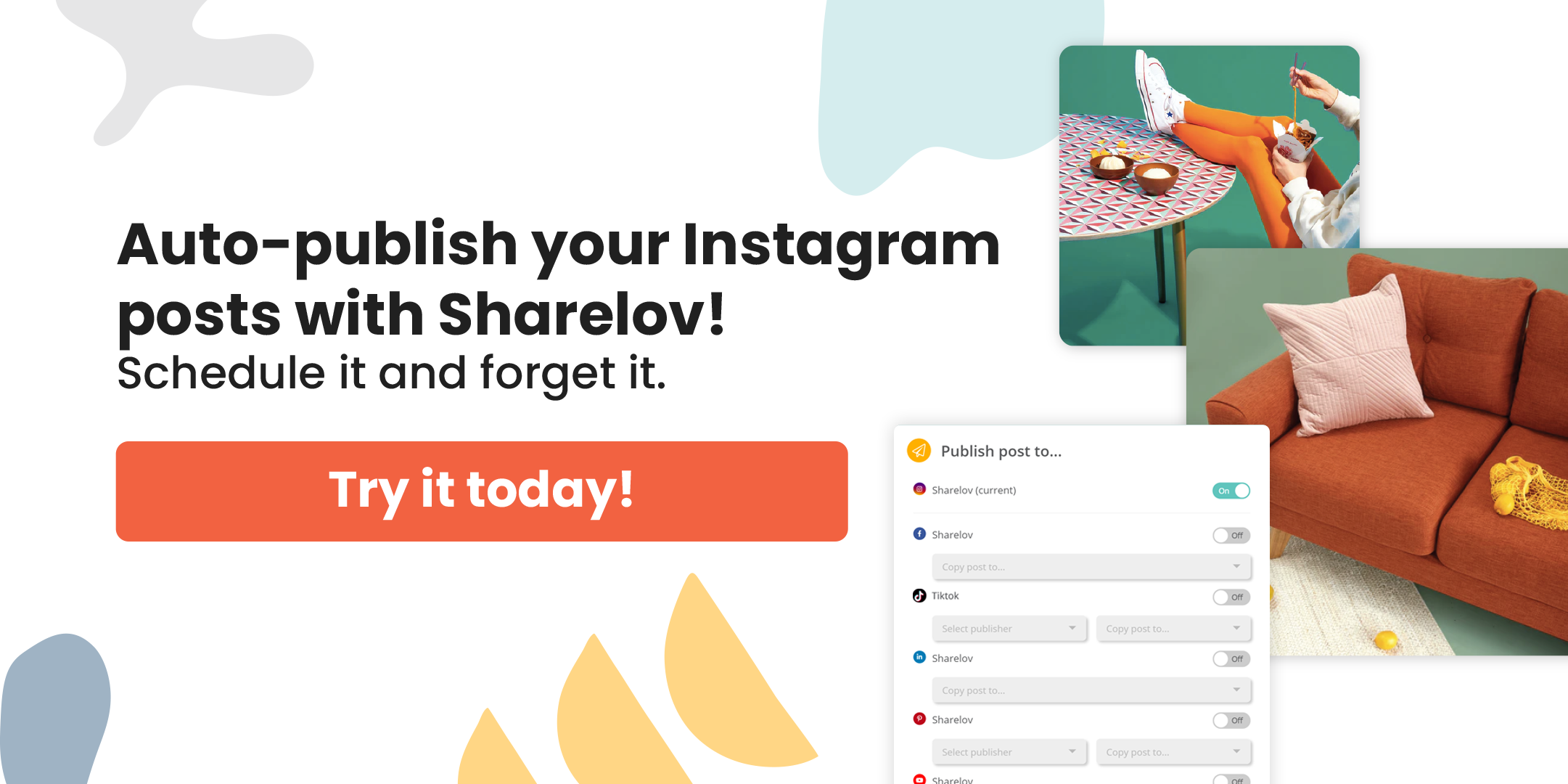Find out how to successfully cross-post content across several social media channels with the tips, tricks, and best practices in this article.
Cross-posting, or sharing one social media post to several different platforms, can be an effective way to boost your brand’s reach and engagement on multiple channels.
To ensure successful social media cross-posting, choose your content carefully and tailor the tone of voice, format, and tools to match each platform. You can cross-post to Instagram, Facebook, and many other platforms, but should avoid reposting on TikTok.
When you do it right, cross-posting can help drive traffic, engagement, and conversions from multiple social media channels. Find out how to optimize your shared posts and check out cross-posting best practices, in the guide below.
Guide To Social Media Cross-Posting
What Is Social Media Cross-Posting?
How To Successfully Cross-Post On Social Media
- Choosing your content
- Choosing your social platforms
- How To optimize posts for Instagram, TikTok, Facebook, Twitter, and LinkedIn
- When to publish cross-posted content
What Is Social Media Cross-Posting?
Cross-posting refers to sharing your content from one social media channel to another, to save the time and effort of creating individual posts for each social media platform. For example, you might share an Instagram post to Facebook or LinkedIn, or share a Tiktok video as an Instagram Reel.
When approached thoughtfully, cross-posting can help expand your reach, followers, and engagement across several social media channels, including
- TikTok
- Youtube
Mention social media cross-posting among a group of marketers, and you’re likely to spark mixed reactions. For some, cross-posting provides an excellent way to boost traffic, engagement, and reach while cutting down on the hours required to promote your brand(s) on social media.
Others, however, associate cross-posting with spam, redundancy, and overall lazy account management.
The truth is, cross-posting is what you make of it.
Done right, you can use it to keep audiences engaged and boost your following across several social channels, even when working with a limited budget and schedule.
In the example below, Adweek Magazine successfully uses cross-posting on Twitter, Facebook, and LinkedIn to promote its latest issue. You’ll notice that the image is the same, but post captions are slightly different to optimize the message for each platform.
Source: Adweek Magazine on Twitter, Facebook, and LinkedIn
If you’d like to engage audiences across several social media platforms without hiring a full staff to create unique content for each network, cross-posting may be a good solution for your team.
Read on to find out how to tactfully cross-post social media content in a way that builds your audience without harming your social media marketing efforts.
Who Should Cross-Post Content On Social Media?
You might be surprised to learn that cross-posting is not a good practice for everyone. While it can provide a time-saving strategy for many brands, we only recommend cross-posting only for teams that have already built an engaged audience on at least one social media channel.
Developing engaged audiences across several social media platforms is no easy task, especially for smaller teams and companies that are stretched thin on resources. And while cross-posting can help speed the process, it’s not a good option for brands who are building a social media audience for the first time.
- Word of warning: Cross-posting is not a good way to build an audience from scratch. Before you can benefit from it, you’ll need to spend time developing a connection with your audience, one platform at a time.
Cross-posting provides a way for newer companies, small companies, and those stretched on resources, to nurture their existing audiences. Large companies even use it to lend an extra “push” to special promotions or campaigns.
However, it can’t replace the one-on-one attention needed when replying to comments and reviews, or the energy it takes to learn about and develop original content for a brand new audience.
- If you’re new to social media, or if your company is brand new, we recommend focusing on one social platform until you are able to connect with and engage people on that channel.
The lessons learned on your first platform will then help you successfully build and grow audiences on multiple platforms.
Once you’ve built an engaged audience on one or two social platforms, you’re ready to benefit from cross-posting!
How To Successfully Cross-Post On Social Media
Successful cross-posting means using the strategy to boost your key KPIs across several social media channels
To get there, however, you’ll also need to meet the precursor goals of avoiding the appearance of spam or wearing out followers who read your content across several social media platforms.
Otherwise, you run the risk of lowering your engagement and conversions, rather than boosting them.
Steer your cross-posting activity in the right direction with the following 4 tips.
Tips For Successful Social Media Cross-Posting:
- Cross-post only your best content and promotions.
- Share cross-posted content to your most engaged social platforms.
- Optimize your captions for each platform.
- Schedule cross-posted content to publish at ideal times.
Successful cross-posting can save your team massive amounts of time and resources, allowing your team to focus more creative energy on campaigns and viral content.
However, if you ignore your cross-posting strategy and simply re-share content across several platforms, you may see your KPIs start heading in the wrong direction.

Below, we take a deep dive into the strategies you need to implement for successful sharing across social media channels.
Tip #1: Cross-Post Only Your Best Content And Promotions
When sharing social media content to other channels, choose only your best posts. If you use caution and avoid too much cross-posting, it will help you avoid the appearance of spam or even laziness.
If you simply repost all your material from one main channel to a handful of others, people will catch on and begin to feel as if you don’t have a real presence on the channel.
However, if you occasionally cross-post content that adds value to your audience, such as special sales and promotions, they’re likely to appreciate it.
Depending on the product you market, you may also cross-post content such as new release announcements, social awareness campaigns, viral content, or other highly-engaging material.
Tip #2: Share Cross-Posted Content To Your Most Engaged Social Platforms.
Cross-posting the right kind of content to your most-engaged social platforms can fuel your engagement and boost your KPIs.
However, if you have a social media channel that’s just not sparking engagement from any of its followers, avoid cross-posting to that channel. That’s a platform that needs extra, personal attention to develop growth and interaction — or perhaps a channel you might consider removing from your lineup.
Cross-posting to your successful social media channels can benefit you by providing additional content to engage your followers and potentially expanding your reach across the platform.
Tip #3: Optimize Your Captions For Each Platform
When you share your unique content from one platform to another, you’ll want to optimize the caption for the platform you’re sharing to.
Each social media platform has its own personality, style, features, and tools. Even though many of the same people frequent different platforms, they expect a different feel on each channel.
For example, LinkedIn users want content and messaging that makes their work-life more productive, while Twitter audiences expect a specific type of humor, commentary, or news. Instagrammers love a stunning aesthetic, right down to the words written in the caption, while Tiktok fans prefer a raw, often in-your-face approach.
How can you take an Instagram post and make it TikTok-worthy or publish a casual Facebook image on LinkedIn?
To optimize your content for cross-posting, tailor the post for each platform using the following tips.

How to optimize content for cross-posting:
- Rewrite the caption in a voice and personality that suits the platform.
- Reduce or expand the length of your caption according to the channel’s character count requirements.
- Add or remove hashtags, tags, and other platform-specific tools.
- Use a marketing software tool instead of on-platform cross-posting tools to avoid social media channel watermarks.
- Check that the image or video meets requirements for the platform, and adjust if needed.
To help you optimize your content for cross-posting, here’s a handy quick-start guide to posting on some of the most popular social media platforms.
| How To Optimize Social Media Posts For Different Platforms | ||||||
| Max character count | Recommended character count | Recommended post image size | Include | Avoid | Voice & personality | |
| 63,000 | 40-80 | 1200px by 630px | Emojis, CTAs, storytelling | Bad grammar, overposting | Informal, playful, engaging | |
| 2,200 | 138-150 | Landscape1080px by 566px | Emojis, hashtags, mentions | Typos, mistakes, lack of hashtags | Light-hearted, inviting | |
| TikTok | 300 | 20-75 (not including hashtags) | Video 1080px by 1920px | Emojis, hashtags, mentions | Shared content, cross-posts | Light-hearted, fun, young |
| 140 (then “see more”) | 100 | Desktop viewing: 552px by 368px
Smartphone viewing: 552px by 672px |
Helpful, informative text, emojis are welcome | Links and hashtags | Business casual, positive, productive | |
| 280 | 71-100 | 1200px by 675px | Keywords, CTA, 1-2 hashtags | Over- Tweeting, too many hashtags, grammar, punctuation, or spelling mistakes | Human, bold is okay for non-sensitive topics | |
How to optimize content for cross-posting to Facebook:
- Adjust the caption length to 40 – 80 characters.
- Incorporate emojis, CTAs, and storytelling.
- Use an informal, playful, and engaging tone.
- Don’t use more than 2 hashtags.
- Best image size is 1200px by 630px (for posts).
- Avoid bad grammar and over-posting.
For example, Netflix uses Facebook to keep its followers in touch with its latest releases and favorite flicks.

Source: Netflix on Facebook
Its captions are casual, informative, and to the point, which helps keep the focus on the video content. This is a perfect approach for their audience.

Source: Netflix on Facebook

How to optimize content for cross-posting to Instagram:
- Adjust the caption length to 138-150 characters.
- Incorporate Emojis, hashtags, and mentions.
- Use a light-hearted, inviting tone.
- Avoid typos and mistakes — and don’t forget those hashtags!
- For landscape post images, use 1080px by 566px.
For example, financial activist @thebrokeblackgirl shares non-judgemental financial information with her 194k+ followers on Instagram. Her tone is down-to-earth and welcoming as she discusses money situations many people can relate to.

Source: @thebrokeblackgirl on Instagram
She includes a tactful number of hashtags and mentions in her posts (usually about one each), and focuses on communicating her message clearly to her followers.

Source: @thebrokeblackgirl on Instagram

When it comes to TikTok, we recommend posting FROM but not TO the platform.
Tiktok users avoid repurposed content, so we recommend never posting from another channel to TikTok.
However, you can post from TikTok to other platforms such as Instagram (Reels), Facebook, YouTube (Shorts), and Twitter.
How to optimize content for cross-posting to LinkedIn:
- Adjust the caption length to 100 characters or less.
- Incorporate hashtags and emojis, mentions when appropriate.
- Consider removing links (LinkedIn posts perform better without them).
- Use a positive and friendly tone of voice, and post only high-quality content.
- If the majority of your viewers browse from their desktop, use 552px by 368px images. If most of your audience views LinkedIn from their smartphones, use 552px by 672px images.
For example, Lego corporation has nearly one million followers on LinkedIn. The brand uses a positive, friendly tone of voice that speaks well to its followers. It also includes emojis and hashtags in nearly every post.

Source: Lego on LinkedIn
Instead of following what other brands are doing, it’s clear that Lego knows its audience well and delivers content and captions that are a perfect fit for its followers and potential customers.

Source: Lego on LinkedIn

How to optimize content for cross-posting to Twitter:
- Adjust your captions to 71-100 characters
- Incorporate keywords, a CTA, and 1-2 hashtags
- Use a very human tone. Boldness is welcome as long as it’s not directed toward a sensitive issue (such as politics).
- Avoid over-Tweeting, using too many hashtags, or making grammar, punctuation, or spelling mistakes.
- Use image sizes of 1200px by 675px.
For example, Dior uses bold, beautiful imagery to capture attention, accompanied by simple captions that support the image.

Source: Dior on Twitter
When appropriate, the brand includes hashtags, emojis, and mentions in its captions.

Source: Dior on Twitter

One of the biggest success factors when it comes to cross-posting is understanding your audience.
A deep understanding of your audience, on each social media channel, can only come from the analytics (insights) that show you how people engage with your content.
Unfortunately, following multiple sets of analytics to keep up with several social media platforms can present a real challenge because it can be time-consuming and require extra attention to detail.
The good news is that high-quality marketing software, such as Sharelov, can help you review and share insights with your team — from several different platforms — in minutes a day.
If you use social media insights to understand what engages your audience, you’ll begin to develop a unique set of guidelines to help your team optimize content for each platform. In the meantime, the chart above can help you tailor your messaging when cross-posting.
Tip #4: Schedule Cross-Posted Content To Publish At Ideal Times.
When cross-posting content, share it at a time that’s ideal for the platform(s) you’re posting to.
For example, the absolute best time for most brands to post on Instagram is weekend evenings, but TikTok users get busy on Tuesdays at 9 am and Thursdays at noon — and YouTubers like Thursday and Friday evenings.
The best times to post to social media vary from one platform to the next and from one audience to another.
If you’re not sure what times are best for your audience, check out Sharelov’s Best Times To Post tool for recommendations on what day and time to post your content to social media. Or, check out any of our Best Times To Post guides on the Sharelov blog!
Bonus Tip: Avoid Platform-specific Cross-posting Tools
Many social media platforms provide sharing tools that allow you to quickly cross-post to other platforms. However, these types of posts are often shared with a watermark or logo stamp from the original platform.
When you post content that has another social media platform’s watermark, you’re announcing to your audience that the post is not original.
Instead of using the cross-posting tools provided, consider re-creating the post or using a marketing software such as Sharelov to publish them.
For example, on Sharelov you can simply duplicate the original post, delegate it to another platform, make edits to optimize it for the new platform, find hashtags and best posting times, and schedule it to auto-publish at the best time for that channel.

Cross-posting requires more effort than re-sharing, so it’s important you have a simple process that allows you to tailor the content for each platform. Typically, you’ll want to edit, change the amount and types of hashtags and mentions, then publish at the ideal time for the new platform.
Using a social media marketing tool to cross-post content can help your team share more quickly and consistently than you would by simply recreating the post.
Cross-Posting Best Practices For Social Media
The following “do’s and don’ts” will help you stay on track for successful cross-posting on social media.
- Do choose your best, most engaging content for cross-posting.
- Don’t cross-post all your content.
- Do cross-post to your most engaging social media channels.
- Don’t cross-post to all your social channels in the hopes you’ll “get lucky.”
- Do optimize the captions and content for each social platform you share to.
- Don’t simply re-share the exact same post to other channels.
- Do schedule cross-posts to publish at the best times for each platform/audience.
- Don’t cross-post over several channels at the same exact time.
As always, keep a close eye on your social media insights when you begin cross-posting. The analytics will show you whether the strategy is helping – or harming – your campaigns.
Following best practices for cross-posting will help your content succeed across multiple social media channels.
Thoughtful Cross-Posting Helps Boost Reach, Engagement, and Conversions
While cross-posting can help you save time and resources, it’s not meant to be a “free ride” to building engaged audiences. It takes time to optimize a post for different social media channels, but, overall, it does cut back on the time, creativity, and energy it takes to connect with different social media audiences.
















